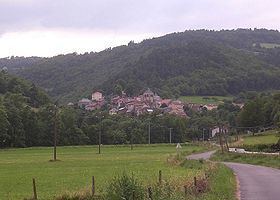Area 19.73 km² | Canton Massiac Population (2010) 205 Local time Thursday 2:02 PM | |
 | ||
Weather 11°C, Wind W at 8 km/h, 59% Humidity | ||
Auriac-l'Église is a French commune in the Cantal department in the Auvergne region of south-central France.
Contents
- Map of 15500 Auriac lC389glise France
- Gerography
- History
- Administration
- Demography
- Civil heritage
- Religious heritage
- Village life
- Notable people linked to the commune
- References
Map of 15500 Auriac-l'%C3%89glise, France
Gerography
Auriac-l'Église is located in the Sianne valley east of the Cézallier mountains some 20 km west of Brioude and 7 km north-west of Massiac. The northern and north-eastern border of the commune is also the border between Cantal and Haute-Loire departments. Access to the commune is by road D9 from Allanche in the south-west which passes through the north of the commune just north of the village and continues north, changing to road D20 at the border. The D21 comes from Massiac in the east changing to the D55 at the border and continuing through the village west to join the D9 west of the commune. The D355 goes south from the village to join the D21 which forms the southern border of the commune. Apart from the village there are the hamlets of Alagnon, Serre, Auriac Bas, and Chaselles. The commune is mixed forest on the slopes and farmland on the plain.
The Sianne river flows through the commune from south-west to north-east before it continues north to join the Alagnon west of Servières. Many tributaries join the Sianne in the commune including the Ruisseau de l'Église, the Ruisseau des Rifs, the Ruisseau de la Bastide, the Ruisseau de Gargaure, the Ruisseau de Fraissinet, The Ruisseau de Balain, and the Ruisseau de Larbounet.
History
In 1855 Friar John Rives of the order of Friars of Saint-Viateur founded a communal school.
In 1899 Friar Camille Mizoule, teacher in Auriac-l'Église and author of La Bretagne à Vol d'oiseau (Brittany Bird Flight) (1898) as well as winner of the Muses armoricaines et Vendéennes award, published a book of poetic essays entitled Auvergne and Brittany.
In 1962 Alphonse Vinatié, (1924-2005), a teacher in the Auriac-l'Église public school and an archaeologist, discovered one of the largest necropolii in France: proto-historic burial mounds in Laurie.
Administration
List of Successive Mayors
(Not all data is known)
Demography
In 2010 the commune had 205 inhabitants. The evolution of the number of inhabitants is known from the population censuses conducted in the commune since 1793. From the 21st century, a census of communes with fewer than 10,000 inhabitants is held every five years, unlike larger towns that have a sample survey every year.
Sources : Ldh/EHESS/Cassini until 1962, INSEE database from 1968 (population without double counting and municipal population from 2006)
